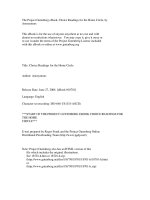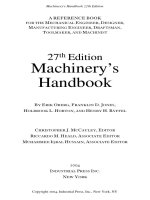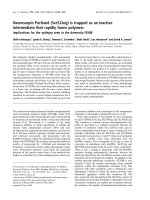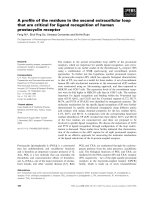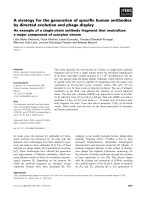Solve for the three dynamic pressures that create neutral stability
Bạn đang xem bản rút gọn của tài liệu. Xem và tải ngay bản đầy đủ của tài liệu tại đây (145.17 KB, 8 trang )
Homework set #2
Due February 4, 2011
A-1
AAE556
Three identical uncambered wing segments are connected to each other by torsional springs
and to the wind tunnel walls by additional torsion springs, as indicated
in the figure. The four
Problem 2.1
torsion springs have the same spring constant K T. The wing segments are mounted on bearings
on a spindle attached to the tunnel walls.
2.1
(a) Develop the equations of static equilibrium at neutral stability. The three degrees of freedom are θ1, θ2 and
(b)
θ3.
Write the expression for the strain energy stored in this configuration as a function of the torsional
displacements. Use the energy method to derive the system stiffness matrix in terms of the three torsional
deflections. Compare this result to that found in part (a). They should be identical.
(c) Solve for the three dynamic pressures that create neutral stability.
(d) Find the mode shapes at all neutral stability points. Describe the mode shapes (how do
the surfaces deflect relative to each other?).
(e) Which of the three dynamic pressures in part (c) is the divergence dynamic pressure?
A-2
Problem 2.2
Two wing sections are mounted on shafts attached to each otherProblem
and to2.2
a wind tunnel wall, as
indicated. Note that the two torsion spring stiffnesses are equal, but are offset an amount d. This
configuration is similar to, but not identical to, the example in Section 2.18. When the sections
are placed in the wind tunnel at an angle of attack αo, the two springs deform, as indicated in the
diagram. Lift on the two, identical, uncambered wing sections is
L1 = qSCLα (α o + θ1 )
L2 = qSCLα (αo + θ 2 )
(a)
Place an aileron on the outer (right-hand) section.
This aileron has aerodynamic coefficients
CLδ and CMACδ
Develop the static equilibrium equations for the system when there is no initial angle of
(b)
(c)
attack, but the control surface is deflected downward an amount δo.
Specialize the result in part (a) by making the aileron flap-to-chord ratio E = 0.15 with d/e = 1 and e/c = 0.10.
Solve for the rolling moment generated by the aileron as a function of dynamic pressure, q.. Use Section 2.18
as an example of how this is done.
Solve for the reversal speed.
Part (a): The static equilibrium equations for the system when there is no initial angle of attack, but the control
surface is deflected downward an amount δo.
2K
− K
d CL c CMAC
δ
d
1 + ÷ δ ÷+ ÷
1
−
e CLα ÷
− K θ1
e CLα
e θ1
= qSeCLα δ o
− qSeCLα
K θ 2
0 1 + d θ 2
d CLδ
÷
÷
e
÷
e
C
L
α
CLδ
CLα
= 0.4805 and
The aileron coefficients are computed to be:
get:
CMACδ
CLα
= −0.0966
. With d/e = 1 and c/e = 10 I
2 −1 θ1
1 −1 θ1
−0.0051
−
q
=
q
δ
o
−1 1 θ
0 2 θ
2
2
0.4805
A-3
÷
÷
( 0.4754 − 0.4703q )
( 0.956 − 0.4805q )
θ1
qδ o
=
2
θ 2 ( 2q − 4q + 1)
The lift on each section is:
0.4754 − 0.4703q
L1
1
2.081q
=
qSC
δ
+
qSC
δ
Lδ o
Lδ o
2q 2 − 4q + 1 ( 0.956 − 0.4805q )
1
L2
(
)
1.021q 2 − 3.011q + 1
÷
L1 = qSCLδ δ o
÷
2 q 2 − 4q + 1
1.00q 2 − 2.011q + 1
÷
L2 = qSCLδ δ o
÷
2 q 2 − 4q + 1
b
M Roll =
4
(
)
(
)
L1 1
3b L1 b
=
1
3
= ( L1b + 3L2b )
4 L2 4
L2 4
M Roll =
(
( 2q
)
qSCLδ δ o 1.005q 2 − 2.261q + 1
2
A-4
)
− 4q + 1
Problem 2.3
The wing idealization is shown in the figure will be tested in the wind tunnel at several different airspeeds
and in several different configurations. All testing is to be done
liftat sea level conditions and at such low
speed that the flow field is incompressible. Changes in the position of the wing box change the wing
shear center position and the offset distance between the shear center and
wingthe
boxaerodynamic center. For
instance, when the shear center is at the mid-chord, when the shear center is at the wing mid-chord the
offset distance e is equal to c/4. Preliminary wind tunnel testing shows that the wing divergence dynamic
100 lb / ft 2 .
pressure is
shear center range
The team aerodynamicist predicts that the ratio CMAC
CLα tunnel wing segment model cross-section
Wind
/
is -0.075 and the lift curve slope is 4.0; the
S =10 ft.2
reference planform area is
αo
. The section angle of attack
for all tests will be pre-set to 3o.
Problem
a) Develop the expression for the lift force when the shear center is located at the mid-chord. Find the
twist angle
θ
as a function of wind tunnel airspeed.
b) Consider the same wing with different wing shear center locations. The offset distance eo = c/4 when
ei
the shear center is located at the mid-chord (part (a)) is to be used as the reference and
when the shear center is moved. Develop the equations for wing lift
ei
ratio
L
is the offset
and twist θ as functions of the
eo
. Write these expressions in nondimensional form, but use the divergence q for the reference
ei
wing as the reference in all expressions, because the divergence speed changes with
ei
(c) Plot wing lift and twist angle vs. airspeed for four
airspeed range between zero and 150 ft/sec.
A-5
eo
.
eo
values of 0, 0.25, 0.50 and 0.75. Use an
Hints for Problem 2.3 in the text
A rigid wing is attached to a wind-tunnel wall by a linear torsion spring. This wing also has a small wing attached to
LS
its tip. The idealized tip surface produces lift
V
according to the assumed simple relationship
St
torsional spring
KT
LS = qStipCL αS α S
A
es
aerodynamic center
αS
CLα S
A
Stip
shear center
where
is the streamwise angle of attack of this small surface;
is the tip surface lift curve slope, while
gap accentuated
is the tip surface area.
for illustration
β
αo +
θ
The tip device is connected to the wing tip by a torsion spring with stiffness k in-lb/radian. When the tip
device
rotates an angle β with respect to the wing tip a restoring torque kβ is generatedview
to oppose
A-A this rotation. V
L = qSCL α α
The idealized wing lift is
enlarged view of
cross-sectional
geometry
α = αo + θ
with
.
Problem 2.4 - Wing with flexible tip support
Problem statement
a) Write the equations of torsional equilibrium for this system when the entire system is given an initial angle
q=
qSeCLα
of attack. Express these equations in terms of the following non-dimensional parameters;
SR =
Stip CLαδ es
kR =
SCLα e
;
k
KT
KT
;
qD
. Derive the characteristic equation for aeroelastic divergence
these parameters.
k R = 10
qD
b) Plot the divergence dynamic pressure parameter
as a function of SR when
in terms of
kR = 1
and
Partial answers
qSeCLα
1 −
÷
KT
qS e C
− tip s Lαδ ÷ k
KT
KT
k
−
÷
KT
qStip es CLαδ
−
KT
A-6
1
qSeC
θ
Lα
α o Stip esCLαδ
=
KT
β
SeC
Lα
÷
2
kR
kR
kR
+
1
+
k
±
+
1
+
k
R÷
R ÷ −4
SR
SR
SR
qD =
2
qSeCLα
q=
KT
SR =
Stip CLαδ es
kR =
SCLα e
with
k
KT
and
SCLα e
kR
k SCLα e
k
=
=
÷
S R KT Stip CLαδ es KT Stip CLαδ es
qDtip
÷=
÷ qD wing
The ratio
is the ratio of divergence q’s for the tip device alone and the wing alone.
q=
qSeCLα
KT
= 0.9083
When kr = 10 and SR = 0.1 then
q=
qSeCLα
KT
= 0.6592
When kr = 10 and SR = 0.5 then
The larger the size of the tip device, the lower the value of divergence dynamic pressure.
R
The divergence dynamic pressure is plotted against the ratio of tip device area beginning with S = 0.1 and ending
R
with S = 1.
System divergence q vs. SR when kR = 0.1
A-7
A-8
